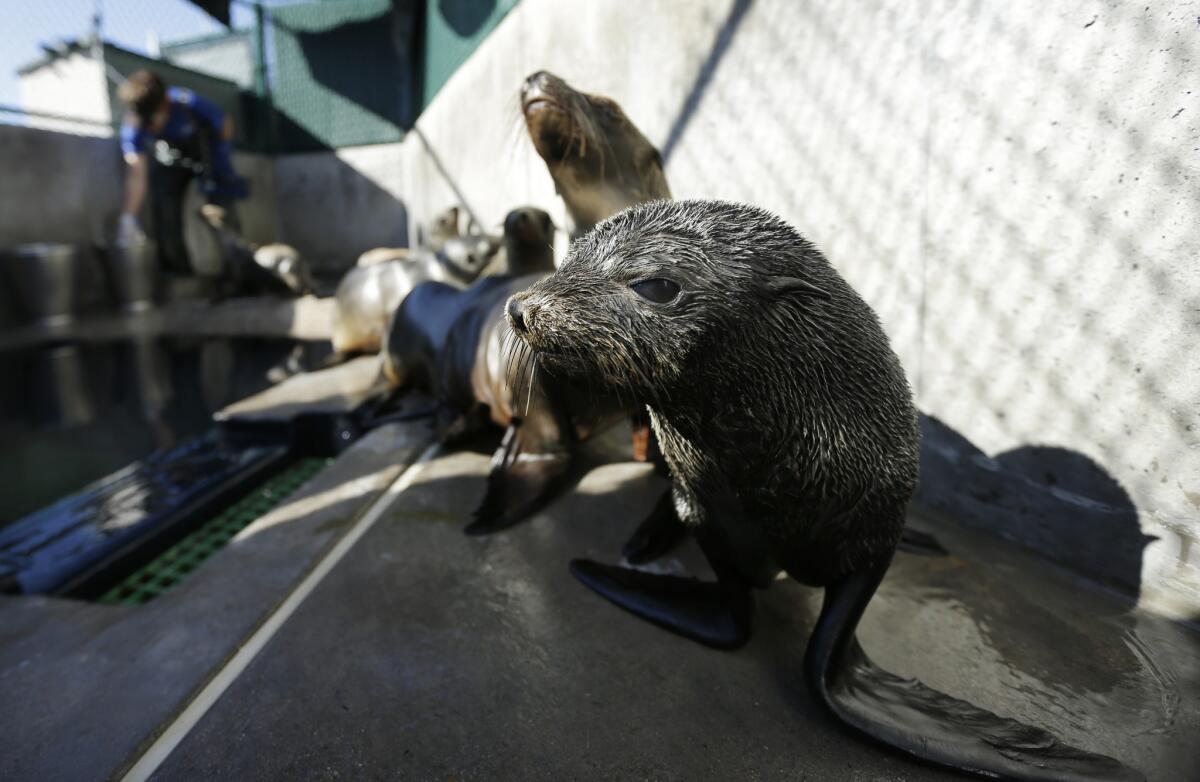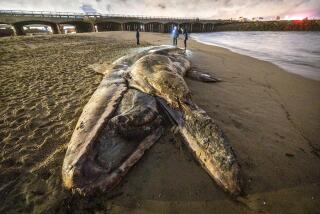Guadalupe fur seals dying at an alarming rate off California coast

A Guadalupe fur seal, front, in 2013 passes by as a SeaWorld animal rescue team member feeds California sea lions at the park’s rescue facility in San Diego.
Guadalupe fur seals are washing up sick and dead at alarming rates along the California coast this year, prompting the National Oceanic and Atmospheric Administration this week to declare an “unusual mortality event” for the animals.
Eighty fur seals have been found stranded along the state’s coast since January, which is about eight times more than normal, officials said. Of those, 42 were dead. But most of the seals found alive were severely emaciated, and only 16 of those 38 were able to be rehabilitated and released back into the ocean, said Justin Viezbicke, an NOAA Fisheries stranding coordinator.
“They’re young animals, and they’re coming in starving to death,” Viezbicke said Thursday.
Most of the animals were pups born last year, officials said. From 1984 through 2014, NOAA recorded an average of 12 stranded fur seals per year, Viezbicke said during a teleconference earlier this week.
Guadalupe fur seals are a threatened species that breed and live almost entirely on Mexico’s Guadalupe Island off the coast of Baja California. The fur seals have not been studied much because of their limited geographic location, but their population is estimated at 15,000, officials said.
Scientists are pointing to warmer waters in the eastern Pacific Ocean as a possible cause for the Guadalupe fur seal strandings. Dubbed “the blob” by experts, an unusually warm mass of seawater that stretches along much of the West Coast has been affecting marine life and the commercial fishing industry.
“We think that warm water conditions have really changed the range of quite a few of the forage fish species that the fur seals would be going after,” said Toby Garfield, director of environmental research with NOAA’s Southwest Fisheries Science Center.
Some species of fish that the fur seals eat may have moved farther north than usual to avoid the warmer waters, Garfield said.
“A lot of them, they don’t know geographic boundaries; they are more interested in water conditions,” Garfield said of the fish.
Garfield said the warmer waters are expected to last at least a few more months and that the coming El Nino, another water-warming event expected to peak this winter, could further affect marine life.
An unusual mortality event was declared for Guadalupe fur seals in Oregon and Washington in 2007, according to NOAA. The species was brought to the brink of extinction by commercial hunting in the 1800s.
NOAA declared an unusual mortality event for California sea lions in 2013, but officials said the number of sea lions found stranded this year is returning to normal.
Twitter: @haileybranson | Google+
ALSO:
Why the founder of #ShoutYourAbortion had to go into hiding
Artist’s fatal shooting spurs safety concerns among Oakland muralists
Has a crackdown on Hawaiian Gardens gang members gone too far?
More to Read
Start your day right
Sign up for Essential California for news, features and recommendations from the L.A. Times and beyond in your inbox six days a week.
You may occasionally receive promotional content from the Los Angeles Times.







